Last Updated: January 18, 2011
Payload Carried on the Pressurized Logistics Carrier (PLC)
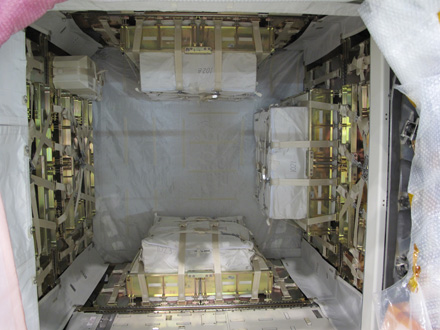
Cargo Layout inside the PLC
KOBAIRO Rack
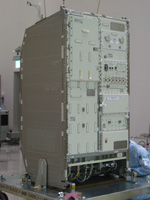
KOBAIRO Rack
KOBAIRO Rack is a JAXA’s science experiment rack. It is installed and operated on board the Kibo Pressurized Module (PM). KOBAIRO Rack accommodates JAXA’s Gradient Heating Furnace (GHF).
The GHF supports semiconductor crystal growth experiments. A semiconductor material sample will be melted and re-crystallized in the GHF electrical furnace. Since the material sample is re-crystallized in a microgravity condition, crystals with high quality and uniformity can be obtained. Using the GHF, investigators will be able to investigate crystallization mechanisms of semiconductor materials.
Temperature of the GHF furnace can be controlled up to 1,600 degrees Celsius, to the point above the melting point of iron. In addition, the GHF can produce various temperature profiles in the range of 500 to 1,600 degrees Celsius with 150 degrees Celsius/1 cm of temperature gradient. The GHF’s highly accurate temperature control capability enables experiments with excellent temperature stability (±0.2℃).
Multi-purpose Small Payload Rack (MSPR)
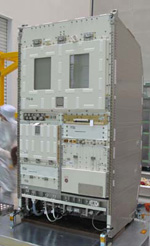
MSPR
JAXA’s Multi-purpose Small Payload Rack (MSPR) is designed to accommodate small experiments of various science fields. The MSPR was developed to satisfy user’s (investigators’) needs, providing an ideal platform for various kinds of experiments. Electrical power and data communications will be supplied to the experiment inserted in the MSPR, so investigators (uses) can develop innovative experiments of their own.
HTV Resupply Racks (HRRs)

CTB

water bags
The HRRs accommodates the Cargo Transfer Bags (CTBs) that contain various supplies, including space food (food in retort pouch, rehydrating food, snacks, rehydrating beverage, and Japanese space food), four water containers filled with potable water, experiment samples, spare parts, and other daily commodities for the ISS crew (such as clothes, soap, and shampoo).
Science Payloads
The following science payloads are delivered to the ISS on the HTV2 Mission.
Sample Cartridges for the Growth of Homogeneous SiGe Crystals in Microgravity by the TLZ* Method (Hicari)
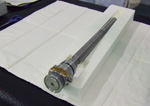
Sample Cartridge (Hicari experiment)
Sample cartridges for Hiari experiment are delivered to the ISS on the HTV2 Mission. The Hicari experiment is the first experiment to be performed using the GHF in KOBAIRO Rack on board Kibo. The sample cartridge containing SiGe samples is heated in the GHF. Hicari experiment aims to verify the crystal-growth theory, and to produce high-quality crystals of SiGe semiconductor.
Experiment Cells for the Marangoni UVP/MaranGogniat
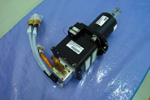
Experiment Cells (Marangoni UVP/MaranGogniat experiment)
The HTV2 delivers experiment cells for the Marangoni UVP/MaranGogniat experiment to the ISS. Marangoni UVP/MaranGogniat is a series of Marangoni convection experiments performed using the Fluid Physics Experiment Facility (FPEF) in the RYUTAI Rack on board Kibo. Within a silicone oil liquid bridge formed into a pair of disks, convection is induced by imposing a temperature difference between the disks. The flow and temperature fields in each stage (e.g., steady, oscillatory, and chaotic flow) are observed using several visualization techniques to determine the transition process.
Sample collection kit for the Biomedical analyses of human hair exposed to a long-term space flight (Hair)

Sample collection kit (Hair experiment)
The HTV2 delivers sample collection kit for the Hair experiment to the ISS. The Hair experiment studies the effects of long-term exposure to the space environment on gene expression and mineral metabolism in human hair. Human hair is one of the most suitable biological specimens for a space experiment since there are no special requirements for handling or for use of hardware. The hair shaft records the information of the astronauts’ metabolic conditions. These samples give us useful physiological information to examine the effects of spaceflight on astronauts participating in long-duration spaceflight missions.
Medical Equipment and medical tools for in-flight crew medical operations
The HTV2 delivers medical equipment and medical tools for in-flight crew medical operations.
Spare Parts and Maintenance Tools
The HTV2 delivers spare parts and maintenance tools for RYUTAI Rack and KOBAIRO Rack.
Plant Seeds (for Asian Communities)

Seeds
On the HTV2 Mission, plant seeds for Asian communities will be delivered to the ISS in the light of the Asian communities’ increasing awareness of/interest in Kibo Utilization. This mission is called “Space Seeds for Asian Future: SSAF 2010-2011”. The seeds flown aboard the ISS will be returned to the ground on the STS-134 Mission (ULF6). These space-flown seeds will be utilized in education programs or science research activities of the following organizations.
- Indonesia
Seed: Tomato (Solanum lycopersicum) and Impatiens (Impatiens balsamina) seeds
Sponsor: National Institute of Aeronautics and Space (LAPAN)
- Malaysia
Seed: Chili pepper (Capsicum) seeds
Sponsor: Malaysian National Space Agency (ANGKASA)
- Thailand
Seed: Chili pepper (Capsicum) seeds
Sponsor: National Science and Technology Development Agency (NSTDA)
- Vietnam
Seed: Salvia splendens, Impatiens (Impatiens balsamina) and Antirrhinum majus (Antirrhinum majus Antirrhinum) seeds
Sponsor: Space Technology Institute (STI) of the Vietnam Academy of Science and Technology (VAST)









